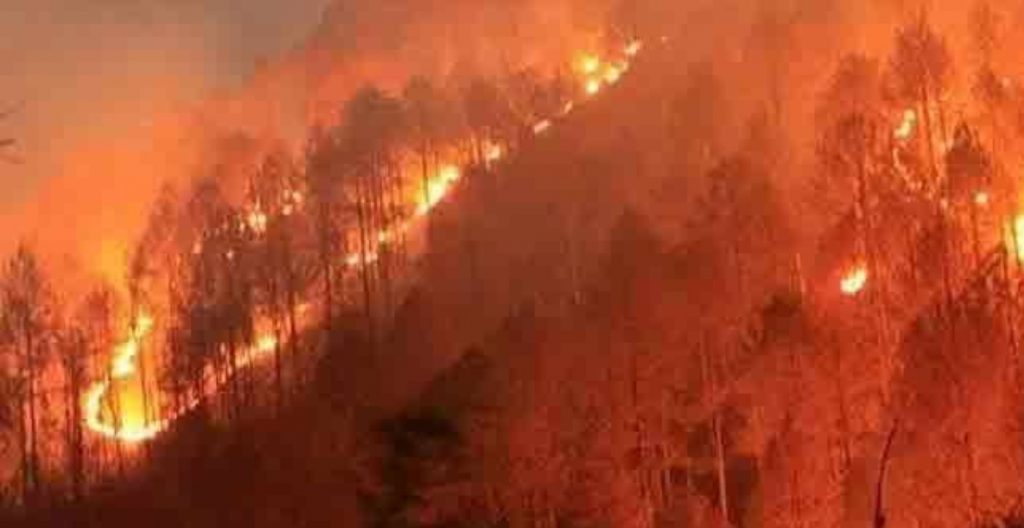 Sariska forest reserve is not prone to fire yet a massive fire broke out in the forest area of Sariska Tiger Reserve in Rajasthan’s Alwar district on 29th March. Which effected the Tiger movement in the area.
Sariska forest reserve is not prone to fire yet a massive fire broke out in the forest area of Sariska Tiger Reserve in Rajasthan’s Alwar district on 29th March. Which effected the Tiger movement in the area.
India’s current heatwave has been early and hotter due to climate change this year. Mercury soaring above 30°C-35°C is good enough to fuel forest fires. Arid regions are more at risk due to their geographical features.
Summer season has kicked off quite early this season. Parts of Central and Northwest India have already witnessed the first round of heat wave conditions as early as in the second week of March. Now, the country is gearing up for another round of intense heat, or we should say one more round of many more heat wave spells to batter India.
As per meteorologists, absence of any weather system has paved way forunabated flow of dry and hot winds across Rajasthan and Gujarat. These winds would eventually blow up to north-western plains along with parts of Madhya Pradesh and Maharashtra as well. Temperatures arelikely to settle past 40 degrees Celsius at several places.
The forest fires in the Sariska tiger reserve look like a case of extreme heat exacerbating the fire. The intensity and increasing frequency of forest fire also points to the dangers this poses for biodiversity. The fire in the reserve which falls under Rajasthan’s Alwar area, has been fanned across an area of 10 square kilometres by unusually hot and dry winds.

Mohan Chandra Pargaien, Additional Principal chief Conservator of Forests, Telangana says that “we need to look for ways out to manage these forest fires as we have less control over the changing environment. Usually estimated economic costs of forest fires in India accounts for loss of standing trees and does notconsider the ecological services such as carbon sequestration, loss of desertification, wildlife, water retention capability, etc. If taken into account, these can increase the loss manifold. Unfortunately, all these services are not getting due recognition and weightage while formulating
strategies to manage forest fires in India. These needs to be addressed with an enabling environment of adequate funding, prioritization and appropriate incentivisation of dependent people residing in fringe areas.”
Dry forests in India, some of which are savannah-woodlands have always had fire as part of their co-evolution. However the increasing intensity of early heatwaves increase the the vulnerability of these forests to fires. While we do not have control over increasing heatwaves and global warming, we need to plan better to manage forest fires. Controlled burns, fire lines and early-warning systems based on improved short-term weather forecasts combined with fire risk mapping are options. Early detection of fires using a variety of existing and new technologies are possible.
The India State of Forest Report 2021 claimed a 177% rise in the forest fire cases between November 2020 and June 2021 against the 2019-2020 period. While forest experts cited this drastic reduction in forest fires in 2019-2020 was mostly due to lockdown driven lack of human intervention, there is no doubt that more fierce and frequent fires are damaging forests’ ability for carbon sequestration.
According to Dr Ravi Chellam, CEO, Metastring Foundation & member, Biodiversity Collaborative “Forest fires are part of the natural ecology of many ecosystems across the world. In fact, there are many habitats and species which are fire dependent. It is the increasing frequency, intensity and scale of these fires which is aided and exacerbated by climate change and that too in the context of accelerating loss, fragmentation and degradation of habitats which is the
problem.”
There is no doubt that Heatwave conditions have aggravated the situation manifolds. Recently released United Nations backed IPCC WGII report on Climate Change 2022: Impacts, Adaptation and Vulnerability has already warned of intense heat gripping India during the co
Intense heat is likely to have a direct bearing on dry forest and also points to the dangers this poses for biodiversity and the decades of efforts which have gone into wildlife conservation.
( Environmentalist & Communicator for Climate Change)
 Jubilee Post News & Views
Jubilee Post News & Views




